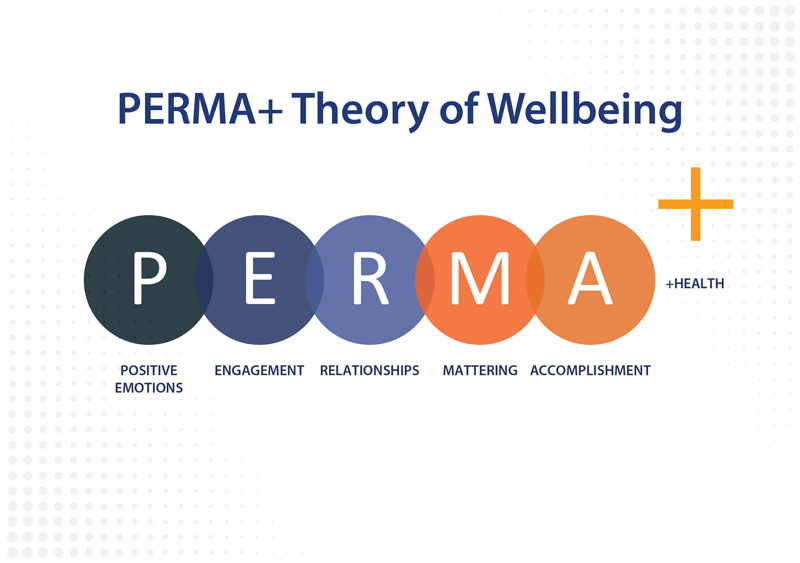James moved into his own apartment in January of 2024. He liked his independence but didn’t have much to say when his support staff spoke with him during their daily video check-in. He was “fine.” His day went “okay.” And, he had nothing to report for wants and needs. James was languishing (Keyes, 2002), and his support staff wanted him to FLOURISH, but they just didn’t know where to start.

Virtual check-in between Remote Support Professional and client at Balance Autism.
So, what does it mean to flourish? The work of Martin Seligman (2011) and colleagues defines flourishing as more than just the absence of suffering and more than just feeling good; it is about experiencing a full, rich, meaningful, and connected life, a “good life.” Decades of research tell us that people who practice the skills of positive psychology (e.g., practicing gratitude, using personal strengths, or mindfulness) can increase their wellbeing and move towards flourishing (Bolier et al., 2013).
James is not unlike other autistic adults; many are not flourishing. The number of autistic individuals who are unemployed and underemployed is unacceptable (Ohl et al., 2017), and data indicate high rates of co-occurring conditions, such as anxiety, depression, and/or mood disorders (Roux et al., 2015). Furthermore, autistic individuals report higher levels of loneliness and poorer physical health than the general population (Jackson et al., 2018; Rydzewska et al., 2021). In short, the autistic community is not okay.
As a result of these poor outcomes, there has been increased interest in understanding and supporting wellbeing within the autism community (Taylor et al., 2023), and one organization in Iowa is taking action.
Balance Autism provides services to autistic children and adults throughout Iowa. Their adult services include vocational and community living supports, focusing on enhancing independence. Early in 2024, Balance Autism launched an innovative program. The SMART Living program creatively uses technology to promote the highest degree of independence for autistic adults in the supportive living program. The program utilizes advanced technology to offer personalized support at various locations throughout Iowa’s municipalities. The remote assistance this program provides includes video conferencing for virtual support and digital schedules and reminders to foster independence and self-determination.
Central to the remote support system are personalized two-way audio and video communication devices installed in each SMART home. These technologies enable clients to connect with staff and vice versa at any hour. Individuals can video call their Remote Support Professionals to discuss their day and communicate any support needs. Remote Support Professionals routinely check in with clients to ensure they receive the necessary assistance. In addition to the two-way screens, custom smart devices are integrated throughout the home to assist with everything from documenting medication administration to managing appointments and monitoring falls.
However, what makes Balance Autism unique is its innovative approach to leveraging technology to support the wellbeing of individuals living in SMART homes. Balance Autism is no longer willing to have James and the other residents languish; the Remote Support Professionals are eager to find additional ways to connect with clients and find additional meaning in their work.
Prior to opening its SMART Living program, Balance Autism partnered with Proof Positive to learn about and develop strategies to integrate wellbeing practices throughout their organization. One of their first implementation projects to promote wellbeing was in their newly developed SMART Living program. As a result, those daily telehealth check-ins now include a wellbeing check-in. Each resident completes a wellbeing check-in using an evidence-informed practice – the PERMA+ Snapshot.

Visual representation of PERMA+ Theory of Wellbeing.
The PERMA+ Theory of Wellbeing indicates that there are six elements critical to human flourishing. (Seligman, 2011)
P = Positive Emotions
E = Engagement
R = Relationships
M = Meaning
A = Accomplishment.
+ = Health (an added element as health is so important to overall wellbeing)
At Balance Autism’s SMART Living program, each of the PERMA+ elements is reviewed with the residents, who provide a self-assessed score between 1 and 10. For example, a resident might report a 9 for Relationship because they went out with their friends to dinner last night and they interacted with a friendly neighbor last night at the apartment building gym – virtual high five. However, they may be low in Accomplishment, maybe around a 3, because they have delayed multiple appointments and the house is a mess – knowing this, the Remote Support Professional can help them develop an action plan to improve that PERMA+ Snapshot score. With this structured approach to tracking wellbeing, James will no longer languish; his support professionals are taking action to ensure he is flourishing.
Tom is another client learning about and benefiting from Balance Autism’s wellbeing practices. When he started at Balance Autism, Tom had not spent much time considering his wellbeing or the elements that contribute to it. He began working with his remote support team and was completing the PERMA+ Snapshot each week. He started to notice patterns in his wellbeing scores and areas where he might need support. For example, Tom observed that his Relationships were consistently low in his PERMA+ Snapshot scores. Upon reflection, he realized that he often struggled with interactions in the community and with his neighbors. He began to focus on the Relationship element. His support team assisted him in identifying the strongest relationships in his life and determining specific behaviors that lead to success. Tom then worked to implement those behaviors with new people. Over time, he saw a positive change in his Relationship score on the PERMA+ Snapshot. For Tom, the PERMA+ Snapshot provided a framework and language to identify areas of needed support that could help enhance his wellbeing.
Remote Support Professionals also report the benefits of integrating the PERMA+ Snapshot. Learning about and incorporating the PERMA+ Snapshot has transformed how they interact with and support their clients. Furthermore, it has enhanced their feelings about their work. As one team member shared, “There is an infectious excitement about my work, and my commitment and job performance are at a higher level” since incorporating PERMA+ into the sessions. Remote support staff indicate that PERMA+ has provided them with a new approach to engaging with the people they serve, fostering meaningful connections. Instead of beginning a session with a generic “How are things going today?” staff can specifically discuss the individual PERMA+ Snapshot scores, delving deeper into what is going well and addressing areas needing additional attention. Focusing on wellbeing has increased collaboration and encouraged targeted discussions about which behaviors and activities contribute to or hinder a client’s wellbeing. Targeted action plans can be collaboratively developed to focus on maintaining or improving various elements of wellbeing.
As research and interest continue to grow around wellbeing and the skills to support a thriving and flourishing life, it is imperative that the autism community is not left behind. As the United Nations declared in 2006, wellbeing is a right for all, including those with disabilities (United Nations, 2006). Learning about and implementing the science and skills of happiness is an essential next step in ensuring that autistic individuals are not left behind, and Balance Autism is leading the way.
To learn more about the science and skills of happiness and how to incorporate them into your program, organization, or home, visit www.proofpositive.org.
Taylor Aukes is Community Services Director of Balance Autism. Paige B. Raetz, PhD, is Vice President of Implementation and Dissemination of Proof Positive.
References
Bolier, L., Haverman, M., Westerhof, G. J., Riper, H., Smit, F., & Bohlmeijer, E. (2013). Positive psychology interventions: A meta-analysis of randomized controlled studies. BMC Public Health, 13, 119. https://doi.org/10.1186/1471-2458-13-119
Jackson, S. L. J., Hart, L., Brown, J. T., & Volkmar, F. R. (2018). Brief report: Self-reported academic, social, and mental health experiences of post-secondary students with autism spectrum disorder. Journal of Autism and Developmental Disorders, 48(3), 643–650. https://doi.org/10.1007/s10803-017-3315-x
Keyes, C. L. M. (2002). The mental health continuum: From languishing to flourishing in life. Journal of Health and Social Behavior, 43(2), 207–222. https://doi.org/10.2307/3090197
Ohl, A., Grice Sheff, M., Small, S., Nguyen, J., Paskor, K., & Zanjirian, A. (2017) Predictors of employment status among adults with Autism Spectrum Disorder. Work, 56(2), 345-355. https://doi: 10.3233/WOR-172492
Roux, A. M., Shattuck, P. T., Rast, J. E., Rava, J. A., & Anderson, K. A. (2015). National autism indicators report: Transition into young adulthood. Life Course Outcomes Research Program, A. J. Drexel Autism Institute, Drexel University.
Rydzewska, E., Dunn, K., & Cooper, S. A. (2021). Umbrella systematic review of systematic reviews and meta-analyses on comorbid physical conditions in people with autism spectrum disorder. The British Journal of Psychiatry, 218(1), 10–19. https://doi.org/10.1192/bjp.2020.167
Seligman, M. E. P. (2011). Flourish: A visionary new understanding of happiness and well-being. Atria Books.
Taylor, E. C., Livingston, L. A., Clutterbuck, R. A., Callan, M. J., & Shah, P. (2023). Psychological strengths and well-being: Strengths use predicts quality of life, well-being and mental health in autism. Autism, 27(6), 1826-1839. https://doi.org/10.1177/13623613221146440
United Nations. (2006). Convention on the Rights of Persons with Disabilities.








